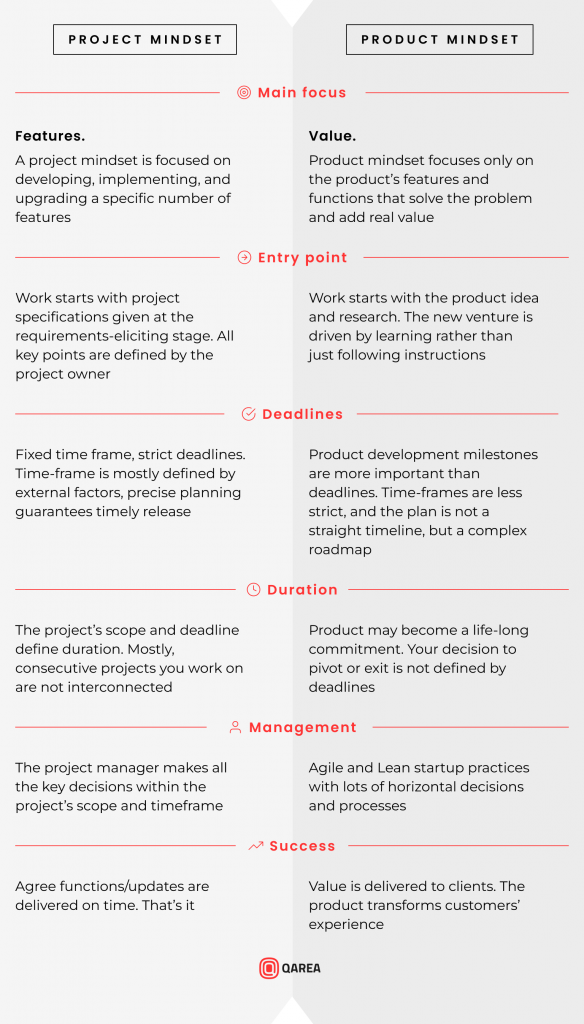Product Mindset vs Project Mindset: Mentality Shift for Startups
by Sasha B. on Sep 26, 2022

Startups have a fantastic vibe. Everything is possible, everyone’s voice is heard, and every step nurtures the anticipation of imminent success. However, navigating this landscape is fraught, as too many startups get stuck in the middle between values vs. deadlines, requirements vs validated learning, product mindset vs. project mindset.
In 2019, Gartner claimed that over 80% of organizations prefer a product-oriented delivery model. Still, three years later, we see this number as more wishful thinking than business reality. The project vs. product mindset battle is still on, and in this article, we want to show you why and how the latter should win.
What Is a Product Mindset in 2022: Experts’ Take
No one creates a company with an expiration date in mind. Why commit to perishable projects when you can invest in your startup’s tenure and endurance? The entire product mindset vs project mindset dilemma is about this choice. Changing minor moves won’t help you achieve the company’s longevity and product’s societal impact, but a shift in mindset that drives your processes might.
A mindset is a “pattern of thought” that allows us to approach tasks and challenges in a certain way. Product mindset puts product over the process and user-centric values over deadline-centered thinking.
As with any holistic approach, the product mindset has numerous definitions and interpretations. Instead of listing them, we give the world to our in-house to name one product-mindset feature that helps them the most. With over 50 years of combined experience, we trust them to pinpoint what makes product mindset so beneficial.
Data-driven decisions
The project environment forces you to play by outdated rules, as it still related mainly to the sequence of dependencies introduced by Gantt in the 1900s. Gantt, and his followers, were fighting for optimization, but they almost fully ignored the human-factor. A rigid project system and communication hierarchy come with ego- and opinion-driven decisions that are not likely to be questioned down the seniority ladder.

“For me, a product mindset is about freedom and data-driven decisions. Product mindset dictates that before committing to any course of action, you must validate the data that supports it, primarily interacting with the target audience. There are many ways to do it; launching MVP and A/B testing are just two of them. In project vs product mindset battle, I choose the latter, as I want to be sure it has value beyond the “release before the deadline” objective.”
Customer-driven development
Agile Radar 2021 claims that product-centric value delivery can result in over 60% growth compared to peers. It proves that taking focus from inner processes to the values the company brings to the customer is not an altruistic gesture, but a business decision that pays back.
“With over 30 years in software development, I have seen and tried most of the models and approaches offered to increase efficiency. Some of them work. However, nothing brings your team more satisfaction than customer-driven development. Everything you do — designing, prototyping, developing — is based on customer needs and feedback. It is rewarding, ethical, and economically justified.

In three decades of negotiating contracts, I have learned that investors’ fundamental question is, “It’s nice, but is someone actually going to pay for it?” A product mindset is about finding the answer to this question earlier than later (or too late).
Build-Measure-Learn loop
Building your development around a product mindset doesn’t mean ignoring deadlines or setting vague milestones. A certain level of predictability is necessary, as no matter how agile you want to be, business is run on numbers, not a perpetual improvisation. Treat deadlines and milestones like instruments, not chains, and your elevation to a product-centered approach will go smoother.

“It is hard to count how many client’s projects could have gone very wrong if we just stuck to a project-based concept instead of implementing a product-centered approach. My team commits to the product, not to the set of imaginary milestones. The build-Measure-Learn loop is when Lean Startup methodology and product mindset come together. This cyclical approach allows you to learn from mistakes for cheap in the beginning, make changes, test them fast, and go back to square one. If you have the means to implement only one product-mindset principle right now, it should be one.”
Further, we will give you an entire roadmap of product-mindset recommendations, with an extended list of instruments for each step. For extra motivation, before you switch to the action mode, check on the advantages that product mindset implementation may bring your startup.
Impress the market with a value-based product you co-create with our dedicated team!

How Startups Can Benefit from Product Mindset
Over 90% of startups fail. This statistic is pretty even across the industry board. It means, no matter your specialty, you want to consider all means to increase your chances. Switching from a project mindset to a product mindset comes with benefits startups can’t ignore.
A long-term vision attracts investment. Startups with a long-term vision are seen as more stable as they commit to a high-level roadmap, considering accumulating risks. Knowing that resources are finite brings startups to test the development ideas before investing in them. It helps to redact unnecessary features, minimize the cost of development and get faster to the actual selling point. Demonstrating your commitment and viable plan to cut expenses simultaneously with increasing the product’s appeal and visibility is a sure way to get some lucrative investment offers.
Customer-centricity helps enter the market right. Even if you are not looking for investment right now, a product mindset will smooth the market entrance and help reduce uncertainty. Putting customers first means taking their needs and feedback over your fantasy about what they may want from your product. Relying on the “fail fast, learn faster” approach, you fix the broken, remove the redundant and update the outdated as you go, way before the release date.
Scalable leadership reveals hidden gems. A startup being driven by several motivated owners is not a rare picture, but what comes next? Rallying behind a strong leader is a natural course of action and may be a successful strategy for a one-act venture. However, building a lasting company requires assembling and nurturing a solid team that can work independently. A product mindset implies empowering experts at various levels to speak up, take responsibility, and use available data for proactive decision-making.
An ethical approach improves employee retention rate. Ethical development minimizes employee burnout and strengthens their connection with end customers and the company, preventing impulsive quitting. A product mindset comes with more respect for all the stakeholders involved, which, by definition, is more ethical and sustainable. Applied ethics greatly intersects with product mindset as both approaches are based on decision-making driven by values, principles, and goals.
Product Mindset vs Project Mindset: a Gap or a Chasm?
Responsibility and commitment are key differences when it comes to project vs product mindset. Project mindset gives all the agents small responsibility at the predefined playground. It is fully focused on deliverables, time and budget, aiming to crossing all the “to-dos” when in the scope of development and updates. Success is defined by certain activities are done in certain time, and the planned features ready within the sequence of codependent deadlines.
Product-mindset engages all the agents in co-creating value and committing to the goals beyond the deadlines. There is not one, not two, but many points assessing which you can decide which mindset defines the development of your startup. Here are some of them:

So, what is the key product vs project mindset difference for business? On the higher level, product mindset switches focus from success proxies — metrics, KPIs, to value-related achievements. On the practical level, it means that DevOps principles — flow, feedback, and continuous improvement — should control and go way beyond software development processes.
We didn’t try to make project management look limited and outdated on purpose. For most innovative startups, it just is. It is a good sign if you feel annoyed and uncomfortable reading the left column — it means you are ready to benefit from everything the product mindset brings to the table.
How to Develop a Product Mindset Within the Team
There are two approaches to shifting any mindset — “become a devoted adept” and “fake it till you make it.” The first implies preaching the product mindset principles, encouraging people to believe in the same values you hold dear. The second one comes with clear steps to accomplish in every sphere of product development. While we can’t teach you how to be an inspiring promoter of the product-mindset idea, we can show you how to implement this approach every step of the way.
Teamwork and cooperation
- Apply the “We are all in this together” approach for both success and failure moments;
- Focus your team’s attention on long-term impact rather than on short-term achievements;
- Invest in autonomy and alignment, pushing self-organizing, product-driven team organization;
- Make sure your team is aware of the strategy and overall agrees with it;
- Focus more on clear OKRs than on industry-standard KPIs
- Ensure buy-in from key stakeholders, including CEO and other top management figures.
Instruments and approaches: Cross-functional teams, Servant Leadership, Retrospectives, Design kits, Constructive feedback, Facilitation instruments, Team Canvas.
Culture and organizational models
- Mitigate fear and hit the brakes on risk-elimination management;
- Put experimentation plan over implementation plan;
- Reduce time dedicated to discovery and delivery cycles;
- Prioritize recovery from failures over avoiding failures;
- Find ways for your team to learn faster from fails;
- See everything as an experiment playground, be at a feature or an entire startup business model;
- Use all possible ways to release and learn faster: A/B tests, alpha/beta releases, white-label experiments, etc.;
- Make collecting data and measuring progress processes uninterrupted;
- Be attentive to opinions of your experienced teammates, but make sure you make data-driven decisions.
Instruments and approaches: Business holacracy, Teal/Turquoise organizations, Workplace Learning, OKR, Schneider’s Culture Model, Vision, Mission & Goal Management
Change management
- Explain the background and virtue of project vs. product mindset shift;
- Make sure the necessity for change is understood by all the stakeholders and accepted by most;
- Articulate the real cost of not changing anything;
- Keep in mind every role that is going to be impacted by the proposed change;
- Destroy the “we don’t have time for improvement narrative”;
- Make small improvements part of every sprint, even when it means you need to push some other tasks to the next one;
- Be ready for product team reshuffles, as the new approach may require new people to step up or down;
- Make sure you have enough resources to implement changes well;
- Expect pushback from your team and prepare for it.
Instruments and approaches: Spiral dynamics, Startup’s lifespan management, Kaizen, Theory of Constraints, System Development Theory, Lean Portfolio Management, Business Model Innovation, Transformational Leadership, Digital Transformation Frameworks
Generating and validating ideas
- Make sure the problem you solve is a “Tier 1” kind of problem, solving one of three top issues your customers expect to deal with;
- Look for product ideas that cover real issues instead of marketing solutions that will sell an ego-driven product;
- Pay attention to your customer complaint records;
- Analyze the existing solutions for pain points your target audience may not be fine with;
- Address big hurdles with precise solutions instead of coming up with big solutions for small inconveniences;
- Involve at least two subject-matter experts in the brainstorming and ideating processes;
- Make ideating sessions more productive by adding structure to meetings;
- Look for cross-industrial approaches and solutions.
Instruments and approaches: User-centric approach, SCAMPER, Design-Thinking, Customer Development, JTBD, Customer Journey Map, Value Proposition Canvas, Circular Design Kit, Depth Interview, Lean Canvas, Validating Board, MVP/MDP, Problem-Solution Fit Canvas, Perceptual map, Lean Canvas
Product development
- Prioritize Time-to-Market over documentation creation and validation;
- Combine strategic and research tasks in one roadmap;
- Focus on MVP development instead of feature pampering;
- Put UX over UI;
- Emphasize developers’ contribution over milestone clearance;
- Accept development as an ongoing cycle, not a straight line;
- Use outsourcing for faster MVP development;
- Make sure to outsource to vendors who share your product-mindset approach.
Instruments and approaches: Data-Driven Development, Unit Economy, AARRR Framework, Goals-Signals Metrics, HADI cycles, Service Blueprint, Experience Mapping, Product Evolution Canvas
Backlog management
- Start working on the next backlog right at the beginning of the current sprint;
- Have up to 2 weeks’ worth of user stories in your backlog;
- Take multiple streams of feedback into account;
- Experiment, turning creating user stories into a group activity;
- Don’t exchange user-centricity with user-obsessiveness;
- Be honest in attributing product’s work items — not everything there is about the user story, and it is normal;
- Use the DEEP approach that defines your product backlog’s quality: Detailed appropriately, Estimated, Emergent, Prioritized.
Instruments and approaches: Impact mapping, GIST planning, Road mapping, Feature canvas, WSFS, Agile backlog management.
High-growth startups choose ethical and efficient instruments to ensure endurance and longevity in an ecosystem that unites business development, technological advancement and societal interests. It is not an easy endeavor, but, luckily, there is more than one way to join in.

Do Outsourcing and Product Mindset Work Well Together?
How do you create a product mindset and make it last enough to leave a sizeable impact? You make sure that everyone working on your product professes the same principles, values, and goals. Earlier, we mentioned how to implement a product mindset in your working environment, now, we will show you a trick or two on how to choose partners sharing your approach.
Vendors: Product Mindset Outside Your Control Zone
There is a misconception that no one except you can genuinely be invested in your product; thus, no outsourcing if you want a product mindset implemented. It is a dangerous idea that undermines the critical concept of the product mindset for startups — creating MVPs and learning from mistakes fast.
You can and should outsource, but cherishing a product mindset, you will have a much smaller pool to choose from. Choosing the right vendors will ensure seamless cooperation and get you the result you were looking for. Unfortunately, there are just not too many outsourcing companies that have completed the shift from project management to product management. Here is what you can do to make such a partnership answer your product-oriented expectations:
Pay attention to signs. As Maya Angelou once said, “When someone shows you who they are, believe them the first time.” The questions vendors ask, the results they choose to showcase, the goals of cooperation they discuss — all this matters much more than any claims you may see on the website.
Show your hand from the start. Many vendors live in a constant race, being used to clients who value deadlines over values and form over substance. Speak first about the product mindset approach and see if you find those who are ready to follow your lead or even bring more product-oriented ideas to the table.
Reframe the purpose. You cannot expect outsourcing companies to work in a product mindset realm when setting objectives within the scope of the project mindset. Double communication harms the result, so start with values and user-centered goals, and only then move to deadlines and milestones.
Product mindset focuses not on features and releases, but on addressing customers’ pain points and continuously changing the product based on their feedback. So far, many startups still follow the project management model. Being established and driven mainly by tech specialists, they fall the canvas habitual to such experts. A cost of success – and even of survival in the modern market – depends on whether you can start thinking like an entrepreneur.
The transition period is not fast or easy, but one of the key steps you can make almost immediately is to choose development partners with product-mindset already inbuilt. They are scarce, as mind shift change is not only a decision, but also an investment, not everyone can afford.
QArea is one of the few outsourcing companies that have gathered and train a team with startups in the realm of product mindset. We help to bring value to customers, and take care of a baseline.

FAQ

Hire a team
Let us assemble a dream team of specialists just for you. Our model allows you to maximize the efficiency of your team.
Written by
We Help With
Your tech partner needs to be well versed in all kinds of software-related services. As the software development process involves different stages and cycles, the most natural solution is to have them all performed by the same team of experts. That’s exactly what our diverse range of services is for.
The choice of technology for your software project is one of the defining factors of its success. Here at QArea, we have hands-on experience with dozens of popular front-end, back-end, and mobile technologies for creating robust software solutions.
In-depth familiarity and practical experience with key technologies are one of the cornerstones of successful software development and QA. But it also takes specific knowledge of the industry to develop a solution that meets the expectations of the stakeholders and propels its owner to success.

Ensure an effective online presence for your business with a corporate site.






















